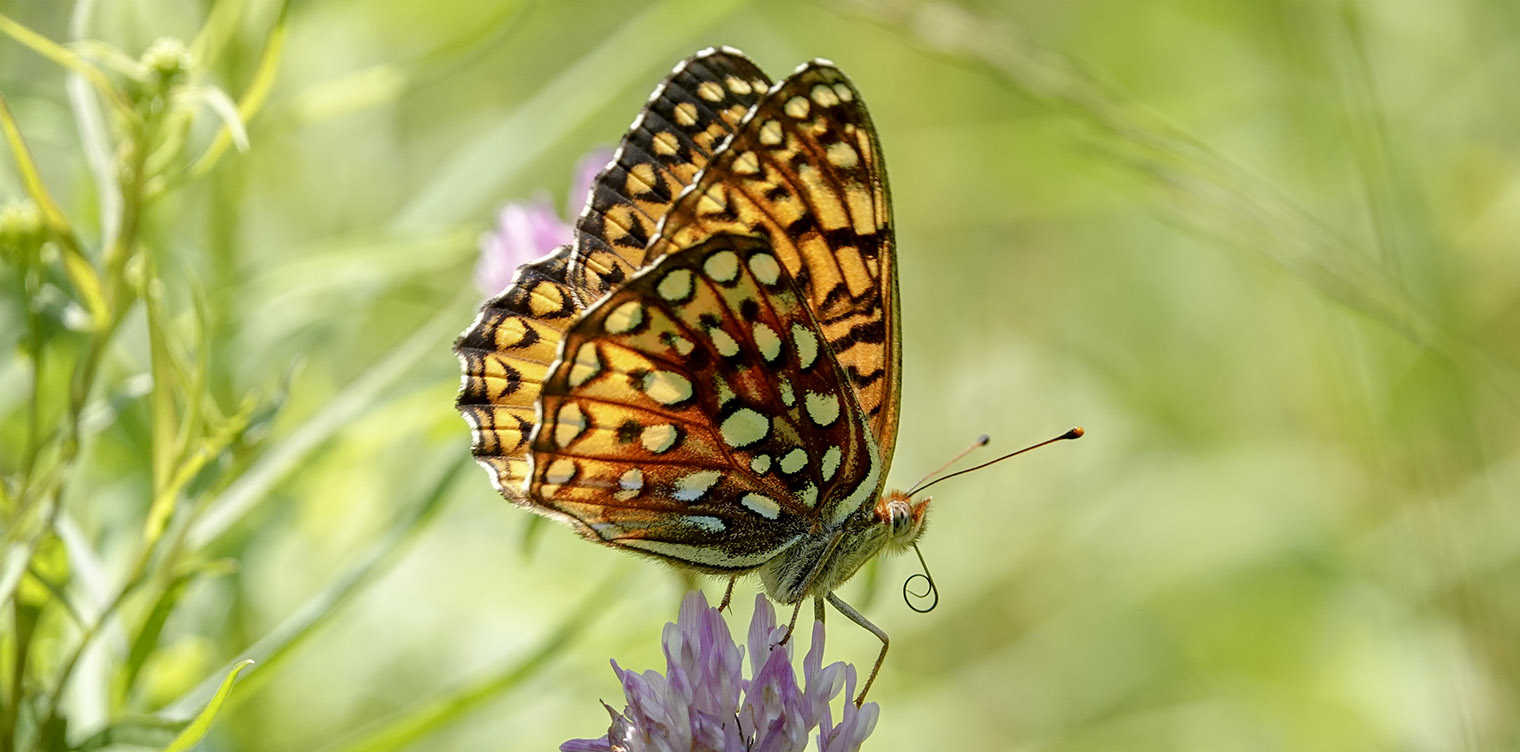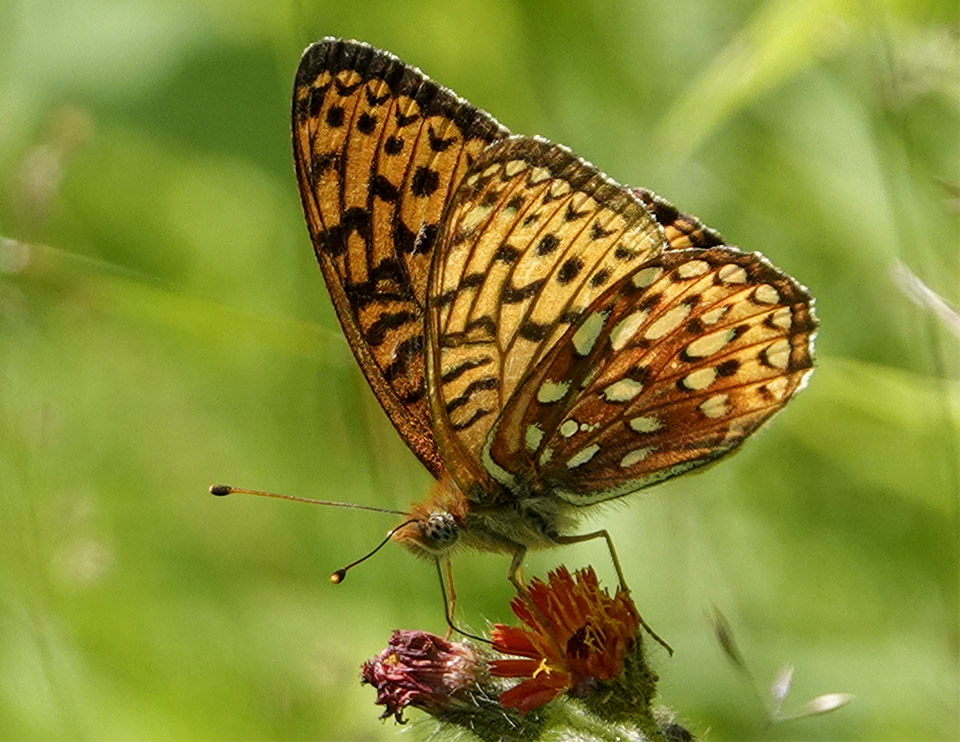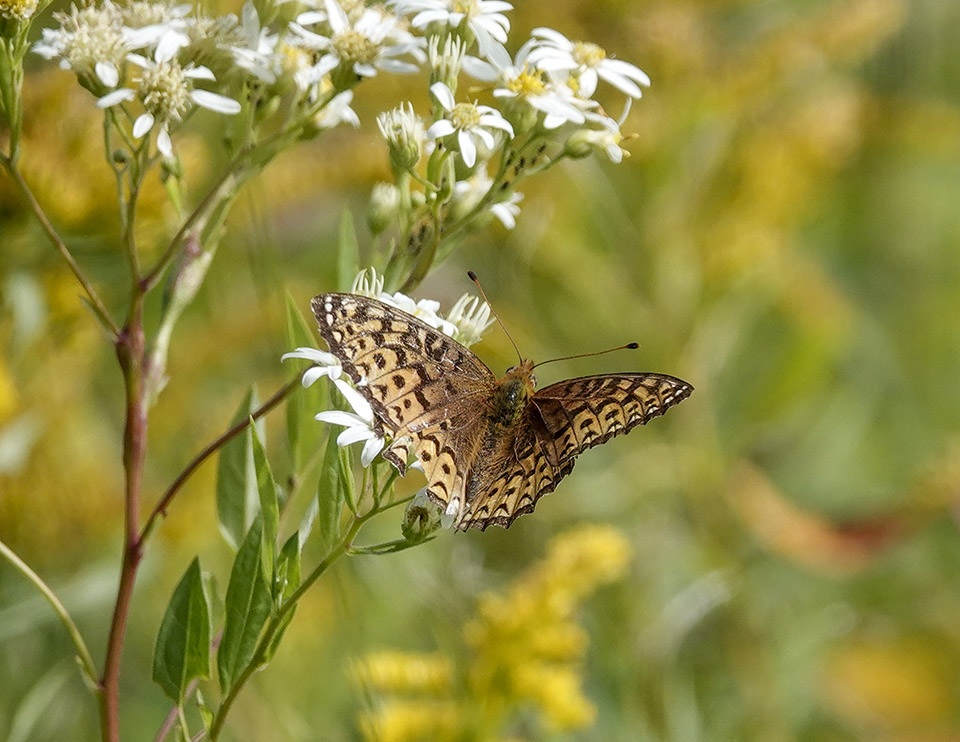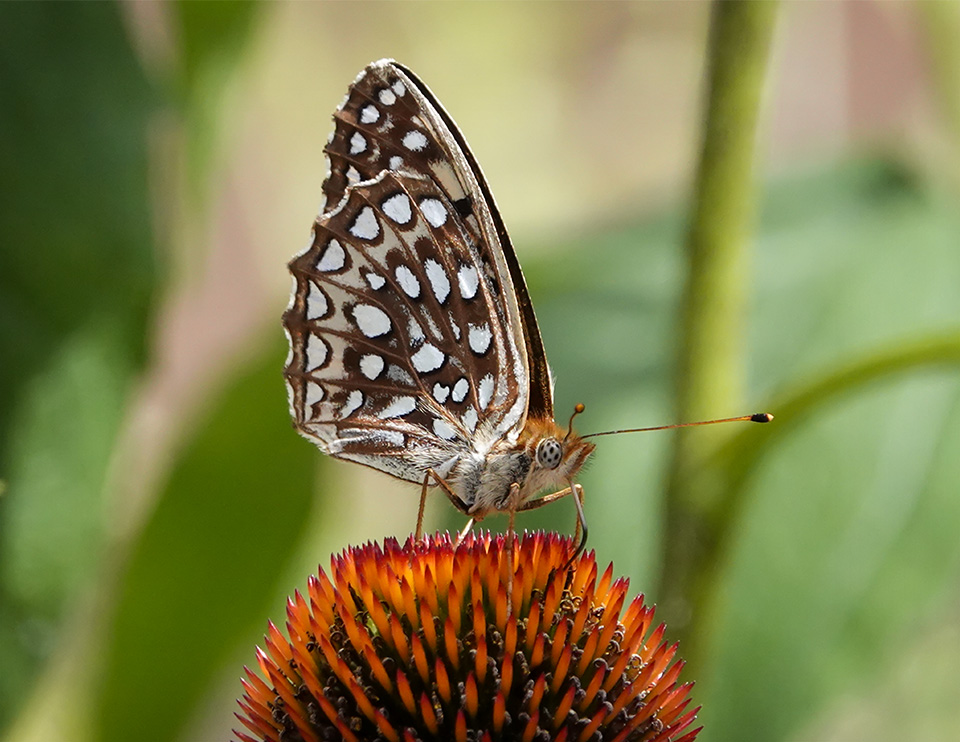Butterflies of the Adirondacks:
Atlantis Fritillary (Speyeria atlantis)

The Atlantis Fritillary (Speyeria atlantis) is a medium-sized orange butterfly which may be seen in the Adirondack Mountains of upstate New York in mid- and late summer.
The species is named after Atlantis, a legendary island first mentioned by Plato. Some sources refer to Speyeria atlantis as Mountain Silver-spot.[1] It is said to be the most boreal of the three large, orange-dappled fritillaries. [2] [3]
Atlantis Fritillary: Identification

The appearance of the Atlantis Fritillary is said to be quite variable. [4] [5] The Atlantis Fritillaries we see here in the Adirondacks may not necessarily be identical to those portrayed in butterfly books. [6] This variability may be due to differences in moisture and temperature. [7]
Most descriptions of the Atlantis indicate that the upper side is orange-brown, lighter yellow or yellowish orange in the female, [8] with a complex black pattern of spots, bars, chevrons, and broadly darkened veins. [9] [10] The upper side is suffused with black at the base and usually has a solid black margin on the fore wings and often on the hind wings as well. [11] [12] [13] [14] The under side of the hind wing is purplish brown and has many silvery-white spots. [15] [16] [17] The wing span of the Atlantis Fritillary is 2.4 inches.[18]
The Atlantis Fritillary is easily confused with both the Great Spangled Fritillary and the Aphrodite Fritillary; and experts do not always agree on how to distinguish the two.
- Most sources agree that the Atlantis Fritillary is somewhat smaller than the Great Spangled and Aphrodite. [19] [20] The Aphrodite is generally lighter orange above with orange rather than solid black borders on the wings, [21] [22] [23] [24] and bright reddish orange rather than dark purplish brown on the hind wings beneath. [25] [26]
- In the Atlantis Fritillary, the black spot at the base of the fore wing from above is usually faint or absent. [27]
- One useful identification feature not often mentioned in guide books is eye color. The Atlantis Fritillary has blue-green or greyish blue eyes, while both the Great Spangled Fritillary and the Aphrodite Fritillary have amber to yellow-green eyes. There is a handy way to remember that the Atlantis Fritillary has blue eyes: Atlantic/Atlantis = Blue ocean/Blue eyes.
Atlantis Fritillary: Life History

Male Atlantis Fritillaries patrol during the day in forested areas or along streams. [28] [29] They chase a female until she lands with her wings closed. The male Atlantis Fritillary then tries to entice her into mating by landing near her and using his wings to waft pheromone to her antennae. [30]
Females lay their eggs singly on leaf litter. [31] The eggs are honey-yellow and are laid near violets. [32] The eggs hatch in 15 to 17 days. [33]
After hatching, the caterpillars overwinter. [34] [35] Mature caterpillars are variable in appearance; [36] some are velvety black with gray or brown stripes and orange spines. [37] Caterpillars feed on violets. [38] [39] [40] [341]
Adult butterflies consume flower nectar from a wide variety of plants, including mountain laurel, ox-eye daisy, spirea, and common milkweed. [42] [43] Adult Atlantis Fritillaries are also attracted to mud and rotting vegetation. [44]
Atlantic Fritillary: Habitat and Range
The habitat of the Atlantis Fritillary includes forest openings, upland pastures, bogs, areas near woodland streams, and meadows. [45] [46] [47] [48] This species is most common in boreal habitats. [49] [50]
The Atlantis Fritillary is found in Canada from the Maritime Provinces and the northeastern portions of the US south to West Virginia, west through the Great Lakes region. [51] [52]
Atlantis Fritillary: Flight

The flight period of Atlantis Fritillaries, as with all butterflies, varies with region and shifts from year to year. Most sources agree that the Atlantis has one brood, but disagree on the flight period. Some sources suggest that the flight period is mostly in July and August. [53] Others indicate that the flight period extends from mid-June to September. [54] [55] The flight period apparently varies with latitude and elevation. [56]
- In Wisconsin, the Atlantis Fritillary reportedly flies from late June through early September. [57]
- In Massachusetts, the single flight period is from mid-June to mid-September, with greatest abundance in July and August. [58]
- In Vermont, the Atlantis Fritillary reportedly flies from early June through the end of September. [59]
The flight period and abundance of the Atlantis Fritillary within the Adirondack Park can only be roughly estimated, based mainly on verified sightings on Butterflies and Moths of North America (BAMONA) and reported observations on iNaturalist.
- The advantage of iNaturalist is that it is a popular citizen science web site that attracts many observers, in part because it covers both plants and animals and in part because the process of submitting an observation is very easy. The disadvantage is that an individual observation can achieve "research-grade" status by being confirmed by the observer and one additional individual, who may or may not have expertise in that particular taxa.
- The advantage of BAMONA is that sightings are verified by regional specialists who are recognized experts. The disadvantage is that there are fewer sighting records for most species, partly because the site covers only butterflies and moths and partly because the process of submitting a sighting is more complicated.
- Both data sets share a common problem of citizen science: reported trends may reflect trends in the number of observers and their willingness to submit reports, not the abundance of the butterfly in question. In addition, the Atlantis Fritillary is quite similar in appearance to the Aphrodite Fritillary and can be easily confused with it if the observer does not have a clear view of the specimen. As a result, the number of recorded sightings may not reflect this species' abundance.
With these caveats in mind, it appears that Atlantis Fritillaries are fairly common in the Adirondack region and usually fly from about mid-June to early September.
- Atlantis Fritillaries have been frequent guests at the Paul Smith's College VIC Native Species Butterfly House (which collects butterflies from the adjacent Butterfly Garden and butterfly-rich sites within a short distance from the VIC.) In 2012, 2013, 2015, and 2016, Atlantis Fritillaries were seen in the Butterfly House and in the adjacent Butterfly Garden more or less continuously from mid-June through late August and early September. [60]
- The list of BAMONA-verified sightings for Atlantis Fritillaries in the Adirondack Park suggests that this species is seen within the Blue Line from mid-June to early September. [61]
Reported observations of Atlantis Fritillaries on iNaturalist suggest a similar pattern. There are significantly more reported observations of Atlantis Fritillaries in iNaturalist than Aphrodite Fritillaries. Most Atlantis Fritillaries were seen in June and July. [62] [63]
- In 2016, there were four Adirondack Park iNaturalist observations of Atlantis Fritillaries, all in late June. [64]
- In 2017, there were seven observations, all in early July. [65]
- In 2018, there were 17 iNaturalist observations for the Adirondack region, the majority from late June to mid-July. [66]
- In 2019, 22 Adirondack Park observations were recorded, from early July to early September. [67]
- In 2020, 39 Adirondack Park observations were recorded, from mid-June to early September. [68]
- In 2021, there were 63 Adirondack Park observations, from mid-June to late August. [69]
- In 2022, 46 Adirondack Park observations were recorded, from mid-June to early September. [70]
References
- Susan Grimm Hanley. Interpretive Naturalist, Paul Smith's College Native Species Butterfly House. Species Logbooks. 2012, 2013, 2015, 2016.
- Butterflies and Moths of North America. Species Profiles. Atlantis Fritillary. Retrieved 10 September 2019.
- Butterflies and Moths of North American. Species Profiles. Confirmed sightings: 6/16/12; 7/12/12; 7/30/12; 7/3/2013; 7/12/2013; 7/12/2013; 7/15/2013; 7/15/2013; 7/18/2013; 7/22/2013; 7/22/2013; 8/5/2013; 8/5/2013; 8/12/2013; 7/5/2014; 6/21/2016; 6/23/2016; 6/25/2016; 7/2/2018; 7/2/2018; 7/4/2018; 7/11/2018; 7/11/2018; 7/15/2018; 8/20/2018; 8/31/2018; 6/15/2019; 7/20/2019; 8/6/2019; 8/26/2019; 9/1/2019; 9/6/2019. Retrieved 10 September 2019.
- iNaturalist. Atlantis Fritillary. Speyeria atlantis. Retrieved 6 January 2023.
- iNaturalist. Adirondack Park Sightings. Atlantis Fritillary. Retrieved 6 January 2023.
- Naturalist. Adirondack Park Sightings. Aphrodite Fritillary. Retrieved 6 January 2023.
- iNaturalist. Adirondack Park Sightings 2016. Atlantis Fritillary. Retrieved 6 January 2023.
- iNaturalist. Adirondack Park Sightings 2017. Atlantis Fritillary. Retrieved 6 January 2023.
- iNaturalist. Adirondack Park Sightings 2018. Atlantis Fritillary. Retrieved 6 January 2023.
- iNaturalist. Adirondack Park Sightings 2019. Atlantis Fritillary. Retrieved 10 September 2019.
- iNaturalist. Adirondack Park Sightings 2020. Atlantis Fritillary. Retrieved 6 January 2023.
- iNaturalist. Adirondack Park Sightings 2021. Atlantis Fritillary. Retrieved 6 January 2023.
- iNaturalist. Adirondack Park Sightings 2022. Atlantis Fritillary. Retrieved 6 January 2023.
- Government of Canada. Canadian Biodiversity Information Facility. Atlantis Fritillary (Speyeria atlantis). Retrieved 10 September 2019.
- Massachusetts Butterfly Club. Massachusetts Butterfly Species List. Atlantis Fritillary. Speyeria atlantis. Retrieved 10 September 2019.
- Massachusetts Audubon. Butterfly Atlas Species Accounts. Atlantis Fritillary. Speyeria atlantis. Retrieved 10 September 2019.
- Kent P. McFarland and Bryan Pfeiffer. Vermont Butterfly Survey. Vermont Center for Ecostudies – Vermont Atlas of Life. Atlantis Fritillary. Speyeria atlantis. Retrieved 10 September 2019.
- Iowa State University. Department of Entomology. BugGuide. Speyeria atlantis - Atlantis Fritillary. Retrieved 10 September 2019.
- Wisconsin Butterflies. Atlantis Fritillary. Speyeria atlantis. Retrieved 10 September 2019.
- The Butterflies of Massachusetts. Atlantis Fritillary. Speyeria atlantis. Retrieved 10 September 2019.
- Montana Field Guides. Atlantis Fritillary. Speyeria atlantis. Retrieved 10 September 2019.
- University of Alberta. Department of Biological Sciences. E.H. Strickland Entomological Museum. Speyeria atlantis. Retrieved 10 September 2019.
- Ross A. Layberry, Peter W. Hall, and J. Donald Lafontaine. The Butterflies of Canada (University of Toronto Press, 1998), p. 172, Plates 13, 21, and 27.
- National Audubon Society. Field Guide to Butterflies (New York: Alfred A. Knopf, 1981), pp. 554-555.
- Jim P. Brock and Kenn Kaufman. Kaufman Field Guide to Butterflies of North America (Houghton Mifflin, 2003), pp. 166-167.
- Paul A. Opler. A Field Guide to Eastern Butterflies (The Peterson Field Guide Series, Houghton Mifflin Company, 1992,1998), pp. 82-83, 240-241.
- James A. Scott. The Butterflies of North America. A Natural History and Field Guide (Stanford University Press, 1986), pp. 330-332.
- Jeffrey Glassberg. Butterflies through Binoculars. The East. A Field Guide to the Butterflies of Eastern North America (Oxford University Press, 1999), p. 106, Plate 28.
- Paul A. Opler and George O. Krizek. Butterflies East of the Great Plains: An Illustrated Natural History (The Johns Hopkins University Press, 1984), pp. 135-136, Plate 23.
- Rick Cech and Guy Tudor. Butterflies of the East Coast. An Observer's Guide (Princeton University Press, 2005), p.165.
- Thomas J. Allen, Jim P. Brock, and Jeffrey Glassberg. Caterpillars in the Field and Garden. A Field Guide to the Butterfly Caterpillars of North America (Oxford University Press, 2005), pp. 82-83.
